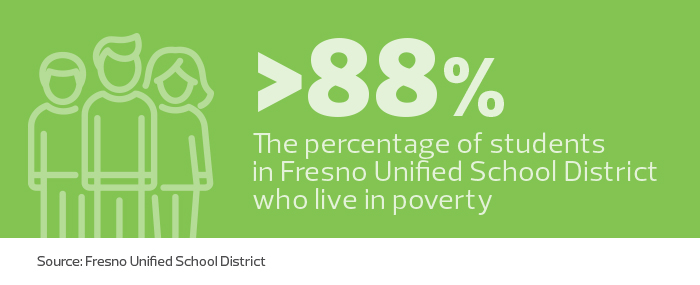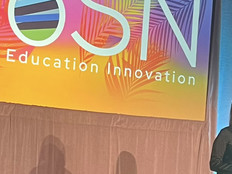K–12 Districts Prepare Students for Careers in the Tech-Dominated Economy
The nut groves, vineyards and cotton fields of the San Joaquin Valley have long been drivers of Fresno, Calif.’s economy and a main source of jobs for the city’s high school and college graduates. That said, as agriculture is increasingly automated and new technology-rich businesses take root in the city, Fresno Unified School District works to keep up, offering students the skills they’ll need to take advantage of emerging career opportunities, says district CTO Kurt Madden.
“Our schools provide internet access and offer year-round career and technology classes,” Madden says. “We also have events and clubs aimed at building student interest and skills.”
FUSD’s students have access to 65,000 Windows-based devices, mostly HP laptops and desktops. The district is also starting a program that will distribute tablets to students for e-learning at home.
With this kind of universal access to technology, students in FUSD high schools can expand their skill set by using CodeCombat resources to learn programming skills (largely through game design), and middle and high school students can participate in extracurricular coding clubs, like CoderGirlz, Madden says.
The forward-thinking district also provides an introduction to emerging technology, such as 3D printers. Events like the district’s Tournament of Technology generate enthusiasm, while students get hands-on experience in applied technology, Madden says. In the tournament, middle school teams compete in 14 events, including Lego robotics, video production and the 3D Derby, where participants use a 3D printer to design and produce cars, and then race them.
The district’s Career Readiness program, part of the formal curriculum, offers 130 courses, many of which prepare students for high-tech jobs or for working with modern office technology. Districts should offer as many ways as they can to engage students in hands-on technology, without regard to scale, says Madden.
“Start small with a robotics competition or a club,” he says. “Interest in technology spreads pretty quickly in young people, and a small initiative will grow.”
SIGN UP: Get more news from the EdTech newsletter in your inbox every two weeks!
Tech Offers a Leg Up for Impoverished Students
More than 88 percent of the students in the district live in poverty, which places them among the young people most in need of technology education, says Alfred Boyd, assistant professor of education at Mississippi Valley State University.
“Students from families with more socio-economic security are doing fine — they’ve had more technology in their lives, and their schools usually offer good access to technology,” Boyd says. “The ‘have-not’ students operate at a disadvantage, both in access and technology training.”
K–12 education is evolving, with more students getting opportunities to explore technology and learning skills for technical careers, says Boyd. “When I was in school, the club that prepared students for the future was 4H,” he says. “I’m in a rural area of Mississippi, and my middle school son is very involved in his robotics club.”
Technology education will improve as schools take a more personalized approach to learning, matching programs to individual interests and abilities, says Boyd. More industry certification programs and apprenticeships in all fields should also give students a leg up on either a career or higher education, he says.
“We want everyone who graduates from high school to be ready, willing and trained to go to work, or ready, willing and trained to go to college — or both,” Boyd says.
Proper Tech Training Includes Certification
Half of Brevard Public Schools graduates who go on to college have jobs while they earn their degrees, says Janice Scholz, director of Career and Technical Education (CTE) in the sprawling district, which serves 75,000 students from 17 communities on Florida’s Space Coast.
“Students think they’re very tech-savvy, and they are when it comes to the apps they use with their friends,” Scholz says. “In the wider world, though, they need applicable job skills.”
As part of a state mandate, all BPS students can earn certification in essential digital skills and tools, such as word processing, coding, spreadsheets and databases. The district has mobile computer labs in all schools and provides Samsung Chromebooks and Lenovo ThinkPads loaded with Google Apps for Education.

Beyond that preparation for the digital world, the BPS CTE department operates 40 training programs out of 170 labs, most of which are equipped with high-end Lenovo computers loaded with enough RAM to handle computer-aided design software. Programs range from early childhood education to applied robotics technology to web application development. Industry certification gives students a way to verify their skills and is a key part of the CTE program, Scholz says.
“If you and I are both applying for a job or an apprenticeship, and you can say that you’re certified in Microsoft Office or SolidWorks and I can’t, then you’ll get the position,” says Scholz. To select the training programs and certifications included in the CTE curriculum, Scholz and her staff look to local industry partners, who point to the IT and other technical skills they need. Those partners also become sources of apprenticeships, internships and job placements, she says.
“Our programs are part of the economic development of the community,” Scholz says. “Employers and parents understand the value of CTE. I think it’s good for all students, regardless of where they want to go when they leave high school.”
School Partnerships Yield Results
On a recent visit to the Somerville Public Schools Culinary Arts program, advisory board members from local food-related businesses were impressed by almost every aspect of the preparation and presentation. But, they noted, by writing orders on a pad, SPS students were behind the times.
“They thought the food was great, but that our students needed to know about electronic ordering and suggested point-of-sale systems we should investigate,” says Leo DeSimone, CTE director for the district, which serves about 5,000 students in Somerville, Mass., just northwest of Boston. “It’s a good example of our partnership with the community, and also of how almost every field uses advanced technology.”
Somerville’s proximity to the booming tech hubs of Boston and Cambridge mean that, for well-prepared students, job possibilities are abundant. “Ninety-eight percent of our kids are tech-savvy, and the district provides access to the tools they need to use technology in their school work,” says DeSimone. “We want to give the students the technology experience and skills that will prepare them for the world beyond high school.”
SPS offers 13 career training programs, which emphasize learning industry-standard technology and techniques, says DeSimone.
“Certifications are built into many programs, in everything from Adobe and Cisco Networking Academy to pediatric first aid,” he says.
The IT and CTE departments plan together to ensure that the SPS infrastructure can support the software and hardware needed for the career training programs, without stretching the district’s technology refresh schedule too far, says DeSimone. “We have to plan years ahead to stay up to date.
Fresno Seeks to Make Coding Inclusive
In 2015, Fresno Unified School District teachers and administrators noticed that there were no girls signing up for high school computer science courses. To counter the notion that technology is a strictly male domain, a few teachers organized CoderGirlz, an after-school program where young women could learn and hone programming skills.
“We started with four clubs, and now CoderGirlz has grown to 15 clubs in the district’s middle and high schools, with plans to double the number of clubs in this coming school year,” says FUSD CTO Kurt Madden. “We’re finding that, for girls who have experience with the clubs, it’s a much easier leap into computer science in high school.”
FUSD’s entry in the FIRST Robotics Competition this year was programmed by three girls who had started in CoderGirlz in middle school.
In response to demand from young men, coed CoderClubs groups have also sprung up in schools around the district. “I think the boys were a little jealous, but now they’re doing fine,” says Madden.







